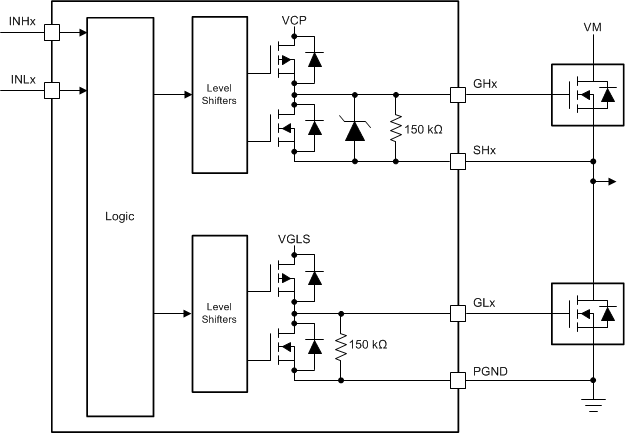SLVSE39B November 2017 – July 2018 DRV8304
UNLESS OTHERWISE NOTED, this document contains PRODUCTION DATA.
- 1 Features
- 2 Applications
- 3 Description
- 4 Revision History
- 5 Pin Configuration and Functions
- 6 Specifications
-
7 Detailed Description
- 7.1 Overview
- 7.2 Functional Block Diagram
- 7.3
Feature Description
- 7.3.1 3-Phase Smart Gate Drivers
- 7.3.2 DVDD Linear Voltage Regulator
- 7.3.3 Pin Diagrams
- 7.3.4 Low-Side Current-Shunt Amplifiers
- 7.3.5 Gate-Driver Protection Circuits
- 7.4 Device Functional Modes
- 7.5 Programming
- 7.6
Register Maps
- Table 1. DRV8304S Register Map
- 7.6.1 Status Registers (DRV8304S Only)
- 7.6.2
Control Registers (DRV8304S Only)
- 7.6.2.1 Driver Control Register (Address = 0x02) [reset = 0x00]
- 7.6.2.2 Gate Drive HS Register (Address = 0x03) [reset = 0x377]
- 7.6.2.3 Gate Drive LS Register (Address = 0x04) [reset = 0x777]
- 7.6.2.4 OCP Control Register (Address = 0x05) [reset = 0x145]
- 7.6.2.5 CSA Control Register (Address = 0x06) [reset = 0x283]
- 8 Application and Implementation
- 9 Power Supply Recommendations
- 10Layout
- 11Device and Documentation Support
- 12Mechanical, Packaging, and Orderable Information
Package Options
Refer to the PDF data sheet for device specific package drawings
Mechanical Data (Package|Pins)
- RHA|40
Thermal pad, mechanical data (Package|Pins)
- RHA|40
Orderable Information
7.3.1.4 Smart Gate-Drive Architecture
The DRV8304 gate drivers use an adjustable, complimentary, push-pull topology for both the high-side and low-side drivers. This topology allows for both a strong pullup and pulldown of the external MOSFET gates.
Additionally, the gate drivers use a smart gate-drive architecture to provide additional control of the external power MOSFETs, take additional steps to protect the MOSFETs, and allow for optimal tradeoffs between efficiency and robustness. This architecture is implemented through two components called IDRIVE and TDRIVE which are detailed in the IDRIVE: MOSFET Slew-Rate Control section and TDRIVE: MOSFET Gate Drive Control section. Figure 20 shows the high-level functional block diagram of the gate driver.
The IDRIVE gate-drive current and TDRIVE gate-drive time should be initially selected based on the parameters of the external power MOSFET used in the system and the desired rise and fall times (see the Application and Implementation section).
The high-side gate driver also implements a Zener clamp diode to help protect the external MOSFET gate from overvoltage conditions in the case of external short-circuit events on the MOSFET.
 Figure 20. Gate Driver Block Diagram
Figure 20. Gate Driver Block Diagram